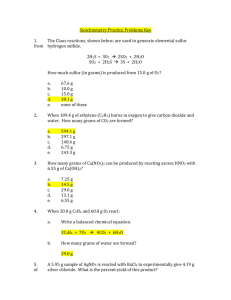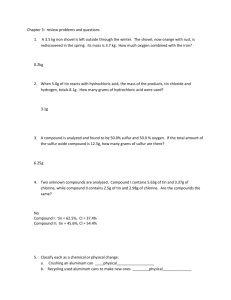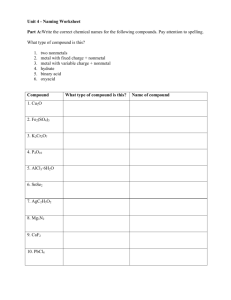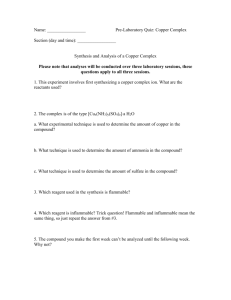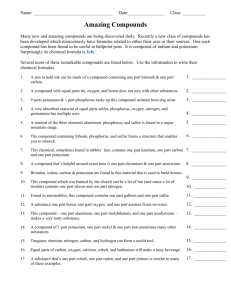Experiment #1 / Unit 4 Investigating Formulas of Compounds
advertisement
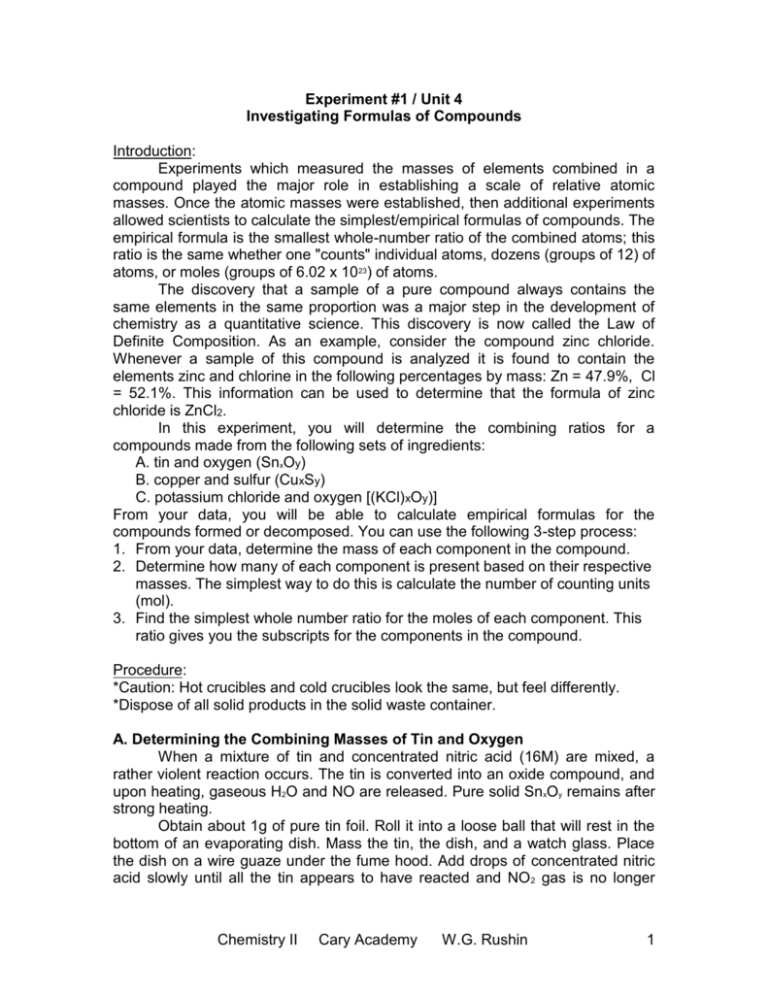
Experiment #1 / Unit 4 Investigating Formulas of Compounds Introduction: Experiments which measured the masses of elements combined in a compound played the major role in establishing a scale of relative atomic masses. Once the atomic masses were established, then additional experiments allowed scientists to calculate the simplest/empirical formulas of compounds. The empirical formula is the smallest whole-number ratio of the combined atoms; this ratio is the same whether one "counts" individual atoms, dozens (groups of 12) of atoms, or moles (groups of 6.02 x 1023) of atoms. The discovery that a sample of a pure compound always contains the same elements in the same proportion was a major step in the development of chemistry as a quantitative science. This discovery is now called the Law of Definite Composition. As an example, consider the compound zinc chloride. Whenever a sample of this compound is analyzed it is found to contain the elements zinc and chlorine in the following percentages by mass: Zn = 47.9%, Cl = 52.1%. This information can be used to determine that the formula of zinc chloride is ZnCl2. In this experiment, you will determine the combining ratios for a compounds made from the following sets of ingredients: A. tin and oxygen (SnxOy) B. copper and sulfur (CuxSy) C. potassium chloride and oxygen [(KCl)xOy)] From your data, you will be able to calculate empirical formulas for the compounds formed or decomposed. You can use the following 3-step process: 1. From your data, determine the mass of each component in the compound. 2. Determine how many of each component is present based on their respective masses. The simplest way to do this is calculate the number of counting units (mol). 3. Find the simplest whole number ratio for the moles of each component. This ratio gives you the subscripts for the components in the compound. Procedure: *Caution: Hot crucibles and cold crucibles look the same, but feel differently. *Dispose of all solid products in the solid waste container. A. Determining the Combining Masses of Tin and Oxygen When a mixture of tin and concentrated nitric acid (16M) are mixed, a rather violent reaction occurs. The tin is converted into an oxide compound, and upon heating, gaseous H2O and NO are released. Pure solid SnxOy remains after strong heating. Obtain about 1g of pure tin foil. Roll it into a loose ball that will rest in the bottom of an evaporating dish. Mass the tin, the dish, and a watch glass. Place the dish on a wire guaze under the fume hood. Add drops of concentrated nitric acid slowly until all the tin appears to have reacted and NO 2 gas is no longer Chemistry II Cary Academy W.G. Rushin 1 being released. Avoid spattering by allowing the reaction to subside before adding more drops. When no further reaction is observed, place the watch glass on the evaporating dish. Adjust your burner to a weak flame and carefully warm the reaction mixture: LISTEN - if you hear spattering, immediately stop heating for a short time before continuing the heating. When you see no further evidence of reaction and no more gases are being evolved, break up the compound gently with a stirring rod and heat strongly for 5 min. Allow to cool and then measure the final mass. B. Determining the Combining Masses of Copper and Sulfur When copper is heated with sulfur, CuxSy is formed and the excess sulfur burns in the air to form the choking gas sulfur dioxide. Mass a clean crucible and cover. Add approx. 1 g of copper to the crucible and re-mass. Now cut the copper into small pieces. Mass approx. 0.6 g of sulfur on a piece of paper. Add this to the copper and mix thoroughly. Set up to heat using the portable fume hood. Place the crucible and cover on a clay triangle and heat, gently at first with the lid on for 5 minutes. Leave a small opening and heat strongly for 5 minutes. The copper and sulfur react to form copper sulfide. The excess sulfur burns off with a light blue flame and produces sulfur dioxide by reacting with oxygen in the air. Heat the upper part of the crucible as well as the lower part to get rid of all the excess sulfur. You may need to heat the underside of the lid to remove all of the excess sulfur. Allow the crucible to cool and then measure the final mass. C. Determining the combining masses of potassium chloride and oxygen When solid potassium chlorate is heated in the presence of manganese dioxide (as a catalyst), oxygen is evolved, leaving a solid residue of manganese dioxide and potassium chloride. To a clean, dry test tube, add a pinch of manganese dioxide catalyst and measure the mass. Add about 1 g of potassium chlorate and re-mass. Gently break up any clumps of potassium chlorate. Make sure there is no foreign material in the tube (this could lead to an explosion!). Carefully mix the two solids until the entire mixture appears gray. Spread out the mixture before heating and avoid heating in one spot. Clamp the top of the test tube to a ringstand at a 30* angle. [If you would like, we can adapt your set-up so that you can collect and test your pure oxygen.] Heat the tube gently until the solid melts and then increase the heat, being careful to avoid vigorous bubbling. Heat until the there is no more oxygen evolved. Allow the tube to cool and then measure the final mass. Data: identity of metal / or nonmetal / or compound used tare (mass of crucible + lid / or test tube + MnO2) tare + reactant tare + product observations Chemistry II Cary Academy W.G. Rushin 2 Calculations (for each part): 1. mass of reactant(s) 2. mass of product 3. mass of combined oxygen / or sulfur / or released oxygen 4. mol or mmol of combined metal / or KCl 5. mol or mmol of combined oxygen / or sulfur 6. mol ratio rounded to correct number of sf 7. simplest ratio (show any rounding and multiplying used to achieve ratio) 8. empirical formula 9. percent error based on the percent by mass (using original masses – not the formula) of one of the elements in the compound 10. Calculate the free energy change for the three main reactions. Will these reactions occur on their own? Which reaction makes the most energy available for useful work? 11. Manganese dioxide was used to speed up the decomposition in part C. How are catalysts able to speed up reactions? Lab Report #4.1: title page abstract (only for your compound) procedure sheet data (1 set for each compound and yours must be 1 of the 3) equations for all (8 equations total. Use true subscripts in equations. Show balancing of tin and nitric acid by redox. Include observations with your part.) calculations for all three compounds results and discussion (only for your compound) Chemistry II Cary Academy W.G. Rushin 3

